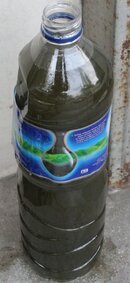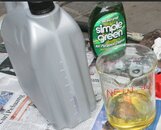Safe thresholds of CO at sea level varies as suggested, and which source you site - but 15 ppm is my personal limit for say 100 ft dive but that's not a safe suggestion, just a personal call.
Government accepted limits for scuba air...
Canada's diving CO spec for air is 5 ppm
USA with its CGA Grade E is 10 ppm
Australia is 10 ppm
Britain has the tightest CO spec at 3 ppm.
http://www.hse.gov.uk/PUBNS/dvis9.pdf
Rest of Europe is 15 ppm
Much of the world - not controlled
The tightest CO level standard is at my small air-fill center......

Its zero PPM CO or no go.

"Alien" tanks coming in will be tested, if more than zero PPM it will be bled to empty and refill. After refill ALL tanks regardless alien or shop owned, will be tested , to make sure its zero PPM CO.
I calibrate my Toxirae 3 and QRAE2 once per 60 days and with 10PPM calibration gas, not with a 50PPM commonly sold.
I use Bauer filter cartridge with hopcalite, even though my Mariner is an electric powered. Even without the Hopcalite type cartridge, I still get zero PPM CO because I maintain my compressor working temperature soooooo like taking care of a beauty queen. I am using Bauer bloody expensive synthetic ( I am sure its Chemlube 800 being rebranded ???...no/yes ? ) it cost me US$85 per LITER in my country or US$321 per gallon.......Dang. In USA its like only US$70 per gallon for Chemlube 800. I plan to import 1 drum of Chemlube 800 and do 200 hour oil change instead of crazy 2,000 hours Bauer reccomendation. Again I am stuck, can't ship oil by air..........dang !!!!
It is easy to bump test, I am a smoker, my breath after a stick of cigarrette will yield 10 to 14PPM as long as I blow slow with the provided calibration cup for at least 8 seconds.
It is easy to actually make CO test gas if you have a known accurate detector still in tune and compressor owner is in a remote area. Use aluminum tank, maybe a small one at 19CF. Use a dummy filter from an old cartridge, clean it well from any oil residue, remove all the media and use its casing to prevent filter housing safety hole from discharging air to atmosphere.
Connect a hose to a car exhaust pipe, small one. Place it at compressor intake. Let some CO get into compressor produced air and since the dummy filter cartridge is there, it wont clean the air. Test it after 500 psi fill. Whatever CO level you get, you can reduce it by blending with clean fresh air produced by a compressor with filter cartridge still in service. Just like making Nitrox....

A car exhaust will easily produce 100PPM CO ( mine has no catalytic converter ) 2 feet from tail pipe. A Honda Powered compressor, that Honda can produced 200-300 PPM easy within 2 feet from the exhaust pipe.
For me based in Indonesia, shipping CO test gas is a pain. It is US$200 shipping cost alone for a 103 liter by air and before tax and excluding gas purchase price. Tax can be up to 30%. In the end what you guys in USA paid for US$100, I will need to pay US$400 at least. I did import anway but by sea freight tagging along a friend shipment in USA. Its much cheaper......its free shipping actually...

I do not know of Analox product but the ToxiRAE 3 is tough, its mining grade but the calibration cup will damage the receiver clip at the unit. Clip and unclip that thing often, after 500+ actions ( I have tested 1000+ tanks.....hahahaha ) , it will loose its edge and will fail to stay clipped properly. My advice is to use a small line, tie that calibration cup down, let that 1 inch clear hose sticks out. Get a hose of a bit bigger diameter to connect to that 1inch hose when testing. If one buy a BCD clip or hose barb flow limiter from TDL, its hose diameter will be a bit bigger than what RAE supply for the calibration cup anyway.
ToxiRAE 3 have proved stable in my 80% humidity and even at sea where its damn humid . I have two of T3 and 1 of QRAE 2, so it is easy to compare when one goes banana.........which not one ever goes banana........yet.
Instructors attached to my air-fill center will carry T3 on every dive trip when using non shop tanks or when shop tanks will be filled by other compressor at the dive destination.
Getting 3-5PPM CO is so common according to the instructors when other compressor filling my tanks. That tanks will be bled empty once it get back to the shop.
My advantage is this Bauer Mariner is brand new as of May 2010. It has been temperature monitored since day 1 and shut down as soon as it gets too hot at 130C+. So I have the benefit of never ( hopefully ) get too much carbon deposit or oxidize my oil. First oil and oil filter change at 100 hours. That factory filled oil at 100 hours is DIRTY !! Planning to do 350 hours oil change maximum with Bauer synthetic and hopefully 200 hours when I can get my hands on those honestly-priced Chemlube 800.
Oil performance is important, it get "old" with use and will slowly reduce its performance.
Water content in oil is something I am still trying to find out. I know my Mariner pumps 10 liters or air to crankcase as blowby and that is MOIST air. I tested the current oil in use after 100 hours, use what the bio-diesel people call crackle test. Pan fried the oil to see if it bubble from water in oil will pop out. My IR gun is out of action for now and I can't tell how hot the pan is and it is gas type kitchen stove not electric one where I can tune temperature more accurately. I heated the oil hot enough for any water to bubble out if any......but I did not get any, fortunately. Then I add two drops of water and the bubble DID pops out....

...so it was hot enough.
Oil perfomance going down the hill and with water in it will damage bearings fast, pit the
piston liner and bla bla......SwampDiver has quoted what Chemlube chemist said about oil life is drastically reduce per 10F above 180F or was it 170F ? What ever it is, poor oil will result in more friction in the end and heat will result. If piston liner gets pitting corossion, it will allow oil to be injected into compression chamber, no matter how good the oil rings are on the piston.
This water in oil issue is what I am not sticking to Bauer 2,000 hours oil life.
Temperature wise I do no worry, my oil at pump output is 50C being hottest, at compression area........I can only guess.
I think Ray Contera has wrote once in his post that Coltri MCH-6 need 50 hours oil change or new oil when in long term storage because the final stage piston sits low and in the oil pool. Failure to change the oil fast will cause corossion on that final stage piston from water. Where does the water come from ?
01. Ambient air for sure, same with diesel fuel getting water in boat's tank. Cool nights and hot days will be like a "water maker" from condensation.
02. Surely that 5% typical blow by of all piston has some contribution. Some older block has more than 5% or piston blow-by.
Ted Green can do 4,000+ hours and still his final stage piston is standard and never replaced........WOW !!! But his oil change is very short too.
This is an interesting article on what water can do to oil :
How Water Causes Bearing Failure
Same thing I do for 1,500RPM diesel engines under my maintenance. 100 hours engine oil change using a 400 hours rated super high performance diesel oil ( factory approved oil list only ). Half life oil is because my country fuel is 350ppm sulhur at least, if not 500ppm. Another half life is because oil is cheaper than early major overhaul, so I use 100 hours as guideline and can get easy 8000 hours trouble free engines before over haul.
Later guys......




 I have decided to only summarize some points; make of it what you will...
I have decided to only summarize some points; make of it what you will...




